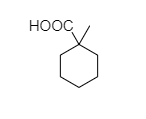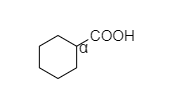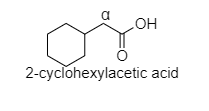
Which compound does not give HVZ reaction?
(A) ${ CH }_{ 3 }-{ CH }_{ 2 }-{ CH }_{ 2 }-{ COOH }$
(B) 
(C) 
(D) 
Answer
454.3k+ views
Hint: HVZ stands for Hell-Volhard-Zelinsky halogenation reaction. The HVZ reaction is halogenation of carboxylic acids at alpha carbon.
Complete step by step solution:
> This reaction is generally carried out by treating carboxylic acids with halogen in the presence of red phosphorus and then works up with water.
> Those compounds which have alpha hydrogen show HVZ reaction while those which do not have alpha hydrogen do not show HVZ reaction.
- In this ${ CH }_{ 3 }-{ CH }_{ 2 }-{ CH }_{ 2 }-{ COOH }$ compound, alpha and beta hydrogen are present. That’s why butanoic acid shows a Hell-Volhard-Zelinsky halogenation reaction.
- In cyclohexyl carboxylic acid, alpha hydrogen is present as shown below,

So, this compound also shows the Hell-Volhard-Zelinsky halogenation reaction.
- In 1-methylcyclohexane-1-carboxylic acid, there is no alpha hydrogen present as the carbon is attached to 4 different bonds. So, this compound does not show the Hell-Volhard-Zelinsky halogenation reaction.
- In 2-cyclohexyl acetic acid, alpha hydrogen is present as shown in the figure;

Hence, this compound shows the HVZ reaction. The correct option is C.
Note: The possibility to make a mistake is that this reaction is specific for the replacement of alpha-hydrogens and not beta- hydrogens.
Complete step by step solution:
> This reaction is generally carried out by treating carboxylic acids with halogen in the presence of red phosphorus and then works up with water.
> Those compounds which have alpha hydrogen show HVZ reaction while those which do not have alpha hydrogen do not show HVZ reaction.
- In this ${ CH }_{ 3 }-{ CH }_{ 2 }-{ CH }_{ 2 }-{ COOH }$ compound, alpha and beta hydrogen are present. That’s why butanoic acid shows a Hell-Volhard-Zelinsky halogenation reaction.
- In cyclohexyl carboxylic acid, alpha hydrogen is present as shown below,

So, this compound also shows the Hell-Volhard-Zelinsky halogenation reaction.
- In 1-methylcyclohexane-1-carboxylic acid, there is no alpha hydrogen present as the carbon is attached to 4 different bonds. So, this compound does not show the Hell-Volhard-Zelinsky halogenation reaction.
- In 2-cyclohexyl acetic acid, alpha hydrogen is present as shown in the figure;

Hence, this compound shows the HVZ reaction. The correct option is C.
Note: The possibility to make a mistake is that this reaction is specific for the replacement of alpha-hydrogens and not beta- hydrogens.
Recently Updated Pages
JEE Atomic Structure and Chemical Bonding important Concepts and Tips

JEE Amino Acids and Peptides Important Concepts and Tips for Exam Preparation

Difference Between Alcohol and Phenol

Classification of Drugs Based on Pharmacological Effect, Drug Action

JEE Main Mock Test Series Class 12 Chemistry for FREE

JEE Electricity and Magnetism Important Concepts and Tips for Exam Preparation

Trending doubts
JEE Main 2025 Session 2: Application Form (Out), Exam Dates (Released), Eligibility, & More

JEE Main 2025: Derivation of Equation of Trajectory in Physics

Electric Field Due to Uniformly Charged Ring for JEE Main 2025 - Formula and Derivation

Degree of Dissociation and Its Formula With Solved Example for JEE

Displacement-Time Graph and Velocity-Time Graph for JEE

Geostationary Satellites and Geosynchronous Satellites - JEE Important Topic

Other Pages
JEE Advanced Marks vs Ranks 2025: Understanding Category-wise Qualifying Marks and Previous Year Cut-offs

NCERT Solutions for Class 12 Chemistry Chapter 1 Solutions

NCERT Solutions for Class 12 Chemistry Chapter 2 Electrochemistry

NCERT Solutions for Class 12 Chemistry Chapter 6 Haloalkanes and Haloarenes

Solutions Class 12 Notes: CBSE Chemistry Chapter 1

NCERT Solutions for Class 12 Chemistry Chapter 7 Alcohol Phenol and Ether




